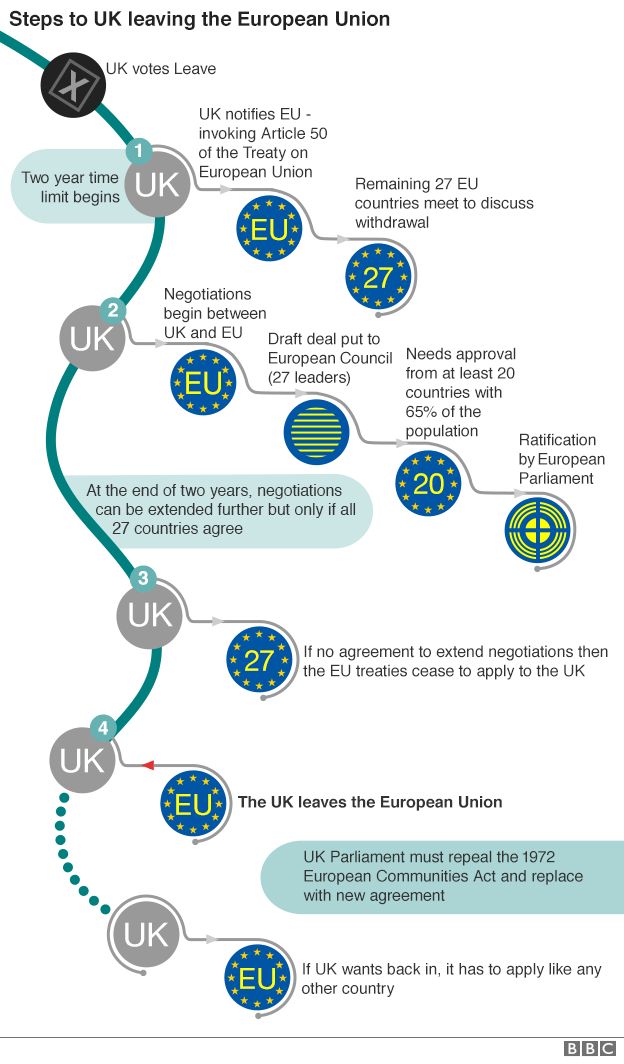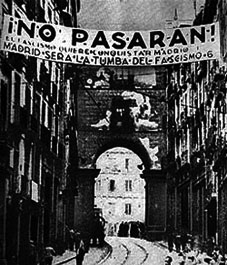Post by Whiterum on Jul 4, 2016 14:09:10 GMT
The UK has voted to leave the EU - a process that has come to be known as Brexit. Here is what is likely to happen next.
The story so far
At exactly 06:00 BST on 24 June it was confirmed that the UK had voted to leave the European Union. The first thing to stress is that the UK will not leave immediately. The UK is still a member of the EU and will probably remain so for several years. But the vote has already triggered an extraordinary chain of events.
A new prime minister needed
In a statement outside Downing Street, David Cameron said the government would respect the result and carry out the instructions of the British people, reassuring the 2.9 million EU citizens in the UK that they will not be adversely affected.
Although it was his responsibility to remain in No 10 to "steady the ship", he announced he would step down in the autumn as he was not the right "captain to steer the country to its next destination".
A new Conservative leader and prime minister is expected to be elected by 9 September.
Under the party's existing rules, Conservative MPs would hold a series of ballots, with all but the two most popular candidates being eliminated. The final two will then go into a run-off in which all Conservative Party members will get a vote. This was the system used to elect Mr Cameron in 2005.
Will Labour follow suit?
Labour leader Jeremy Corbyn has come under huge pressure from within his party to consider his position but he has insisted he will not step down.
MPs have passed a motion of no confidence in Mr Corbyn, accusing him of weak leadership during the referendum campaign and he is trying to fill gaps in his shadow cabinet following a wave of resignations.
This is not a formal mechanism for removing Mr Corbyn and he could survive even if the vote, should it take place, went against him.
He has warned: "Those who want to change Labour's leadership will have to stand in a democratic election, in which I will be a candidate."
His critics had hoped the vote and resignations might force him to either step down voluntarily or precipitate a formal challenge - which would require 50 MPs to write to the party's general secretary and a challenger to come forward with sufficient nominations to get on the ballot paper.
Shadow chancellor John McDonnell has effectively challenged the would-be challengers, saying that even if Mr Corbyn was forced to stand for re-election, he would win when it came to a vote of the party members and supporters. This one looks set to run for a while yet.
The markets react LINK
European leaders respond LINK
Pushing the exit button
There is a formal legal process for withdrawing from the EU - enshrined in Article 50 of the 2009 Lisbon Treaty - although it has never been invoked before.
Mr Cameron has said it should be up to his successor to decide when to activate Article 50 by notifying the European Council. Once this happens, the UK is cut out of EU decision-making at the highest level and there will be no way back unless by unanimous consent from all other member states.
Quitting the EU is not an automatic process - it has to be negotiated with the remaining 27 members and ultimately approved by them by qualified majority. These negotiations are meant to be completed within two years although many believe it will take much longer. The European Parliament has a veto over any new agreement formalising the relationship between the UK and the EU.

Who will lead Britain's negotiations? LINK
The most senior members of the government - David Cameron, Chancellor George Osborne, Foreign Secretary Philip Hammond and Home Secretary Theresa May - are all Remain supporters and some of them may choose to depart when the PM stands down.
The story so far
At exactly 06:00 BST on 24 June it was confirmed that the UK had voted to leave the European Union. The first thing to stress is that the UK will not leave immediately. The UK is still a member of the EU and will probably remain so for several years. But the vote has already triggered an extraordinary chain of events.
A new prime minister needed
In a statement outside Downing Street, David Cameron said the government would respect the result and carry out the instructions of the British people, reassuring the 2.9 million EU citizens in the UK that they will not be adversely affected.
Although it was his responsibility to remain in No 10 to "steady the ship", he announced he would step down in the autumn as he was not the right "captain to steer the country to its next destination".
A new Conservative leader and prime minister is expected to be elected by 9 September.
Under the party's existing rules, Conservative MPs would hold a series of ballots, with all but the two most popular candidates being eliminated. The final two will then go into a run-off in which all Conservative Party members will get a vote. This was the system used to elect Mr Cameron in 2005.
Will Labour follow suit?
Labour leader Jeremy Corbyn has come under huge pressure from within his party to consider his position but he has insisted he will not step down.
MPs have passed a motion of no confidence in Mr Corbyn, accusing him of weak leadership during the referendum campaign and he is trying to fill gaps in his shadow cabinet following a wave of resignations.
This is not a formal mechanism for removing Mr Corbyn and he could survive even if the vote, should it take place, went against him.
He has warned: "Those who want to change Labour's leadership will have to stand in a democratic election, in which I will be a candidate."
His critics had hoped the vote and resignations might force him to either step down voluntarily or precipitate a formal challenge - which would require 50 MPs to write to the party's general secretary and a challenger to come forward with sufficient nominations to get on the ballot paper.
Shadow chancellor John McDonnell has effectively challenged the would-be challengers, saying that even if Mr Corbyn was forced to stand for re-election, he would win when it came to a vote of the party members and supporters. This one looks set to run for a while yet.
The markets react LINK
European leaders respond LINK
Pushing the exit button
There is a formal legal process for withdrawing from the EU - enshrined in Article 50 of the 2009 Lisbon Treaty - although it has never been invoked before.
Mr Cameron has said it should be up to his successor to decide when to activate Article 50 by notifying the European Council. Once this happens, the UK is cut out of EU decision-making at the highest level and there will be no way back unless by unanimous consent from all other member states.
Quitting the EU is not an automatic process - it has to be negotiated with the remaining 27 members and ultimately approved by them by qualified majority. These negotiations are meant to be completed within two years although many believe it will take much longer. The European Parliament has a veto over any new agreement formalising the relationship between the UK and the EU.

Who will lead Britain's negotiations? LINK
The most senior members of the government - David Cameron, Chancellor George Osborne, Foreign Secretary Philip Hammond and Home Secretary Theresa May - are all Remain supporters and some of them may choose to depart when the PM stands down.


